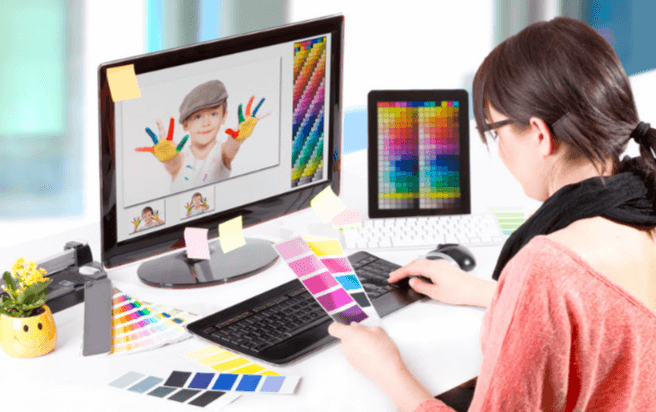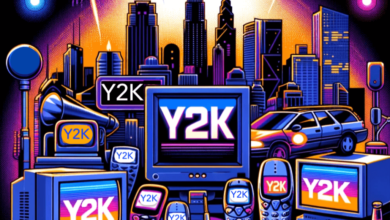Top Graphic Design Trends for 2024

Introduction
Graphic design is ever-evolving, with new trends emerging every year that push the boundaries of creativity. As we move into 2024, designers are embracing innovative technologies and drawing inspiration from both the past and the future. From the integration of artificial intelligence (AI) in design processes to the resurgence of retro-futuristic aesthetics, this year promises to be a dynamic and transformative period for graphic design. Whether you’re a seasoned designer or just starting, understanding these trends will help you stay ahead of the curve and create visually compelling work that resonates with contemporary audiences.
Emerging AI-Powered Design Tools
Artificial intelligence is no longer just a buzzword; it’s a game-changer in the design industry. In 2024, AI-powered design tools are becoming more sophisticated, offering designers unprecedented efficiency and creativity. These tools can generate design elements, suggest color schemes, and even create entire layouts based on minimal input. AI can analyze vast amounts of data to identify what works best in design, helping designers to make more informed decisions quickly. This trend is not about replacing human creativity but augmenting it, enabling designers to focus on the conceptual aspects of their work while AI handles the repetitive tasks.
The Rise of 3D and Immersive Visuals
3D design has been gaining momentum in recent years, and 2024 is no exception. The demand for immersive and hyper-realistic visuals is at an all-time high, driven by the increasing use of virtual reality (VR) and augmented reality (AR) in various industries. Designers are experimenting with 3D elements to create depth and realism in both digital and print media. From product packaging to website design, 3D graphics add a layer of sophistication and engagement that flat designs can’t match. This trend is also pushing the boundaries of what’s possible in animation, with more dynamic and interactive visuals becoming the norm.
Bold Minimalism: Less is More
Minimalism has been a staple in design for years, but in 2024, it’s taking on a bolder approach. Designers are stripping down visuals to their core elements, using stark contrasts, large typography, and vibrant colors to create striking and memorable designs. This trend emphasizes clarity and simplicity, but with a twist—each element is carefully chosen to make a powerful statement. Bold minimalism is particularly effective in branding and advertising, where the goal is to communicate a message quickly and effectively. By focusing on essential elements, designers can create impactful visuals that stand out in a cluttered digital landscape.
Retro-Futurism: The Best of Both Worlds
Retro-futurism is making a strong comeback in 2024, blending nostalgic elements from past decades with futuristic design concepts. This trend is characterized by the use of neon colors, geometric shapes, and futuristic fonts that evoke a sense of optimism and innovation. Retro-futurism taps into the collective memory of what the future was imagined to be, combining it with contemporary design techniques to create something entirely new. It’s a celebration of the past’s vision of the future, reimagined through a modern lens. This trend is particularly popular in branding, where it helps create a unique and memorable identity.
The Organic Design Movement
As the world becomes more environmentally conscious, the organic design movement is gaining traction. In 2024, designers are increasingly using natural elements, earthy color palettes, and organic shapes to create designs that reflect a connection to nature. This trend is not just about aesthetics; it’s about promoting sustainability and environmental responsibility through design. Whether it’s through the use of eco-friendly materials or by creating designs that mimic the natural world, organic design is all about creating a sense of harmony and balance. This trend is particularly prominent in packaging design, where the use of recycled materials and biodegradable inks is becoming more common.
Motion Graphics and Kinetic Typography
Motion graphics and kinetic typography are becoming more prevalent in 2024 as digital media continues to dominate. These dynamic elements are being used to create engaging and interactive experiences that captivate audiences. Whether it’s in social media ads, website banners, or digital presentations, motion graphics add a layer of interactivity that static designs can’t offer. Kinetic typography, which involves moving text, is also being used to convey messages in a more dynamic and visually appealing way. This trend is particularly effective in video content, where the movement of text and graphics can help to guide the viewer’s attention and emphasize key points.
Dark Mode Dominance
Dark mode has been around for a few years, but in 2024, it’s becoming a design standard rather than a feature. More and more websites and apps are offering dark mode as the default option, and designers are adapting to this by creating visuals that are optimized for darker backgrounds. This trend is not just about aesthetics; dark mode is easier on the eyes and can help reduce energy consumption on OLED screens. Designers are experimenting with color palettes, contrast, and light elements to create designs that are both visually striking and functional in dark mode. This trend is particularly important in UI/UX design, where the user experience is paramount.
Maximalism: Breaking the Rules
In contrast to minimalism, maximalism is all about breaking the rules and embracing excess. This trend is characterized by the use of bold colors, intricate patterns, and a mix of various design elements to create a rich and immersive experience. In 2024, maximalism is making a strong statement in interior design, fashion, and graphic design. It’s about creating a visual feast that overwhelms the senses in the best possible way. Designers are using maximalism to challenge traditional design conventions and push the boundaries of what’s possible. This trend is particularly popular in editorial design and branding, where the goal is to create something that stands out and leaves a lasting impression.
Inclusive and Accessible Design
Inclusivity and accessibility are no longer optional; they’re essential components of good design. In 2024, there’s a growing emphasis on creating designs that are accessible to everyone, regardless of their abilities. This includes everything from choosing color palettes that are legible for people with color blindness to ensuring that websites are navigable for those with visual or motor impairments. Designers are also focusing on inclusivity by representing diverse cultures, genders, and identities in their work. This trend is about making design more democratic and ensuring that everyone can engage with and enjoy the content.
AI-Generated Art: A Creative Revolution
AI-generated art is one of the most exciting trends of 2024. While AI has been used in design for a few years, it’s now being harnessed to create entirely new forms of art that were previously unimaginable. AI algorithms can analyze and recreate artistic styles, generate original artworks, and even collaborate with human artists to produce unique pieces. This trend is revolutionizing the way we think about creativity and the role of technology in the creative process. AI-generated art is being used in everything from advertising to fine art, pushing the boundaries of what’s possible in the visual arts.
Typography as Art: Beyond Words
Typography has always been a crucial element of graphic design, but in 2024, it’s being elevated to an art form in its own right. Designers are experimenting with typefaces, layouts, and compositions to create typographic designs that are as visually compelling as they are communicative. This trend is characterized by the use of custom fonts, hand-drawn lettering, and unconventional layouts that challenge traditional typographic conventions. Typography is no longer just about readability; it’s about making a visual statement. This trend is particularly prominent in branding and editorial design, where the right typography can convey a brand’s personality and ethos.
Mixed Media and Collage Art
The use of mixed media and collage art is on the rise in 2024, as designers look to create more tactile and visually interesting work. This trend involves combining various materials, textures, and images to create layered, multidimensional compositions. Collage art, which involves assembling different elements to create a new whole, is particularly popular in editorial design and advertising. This trend is all about breaking down the boundaries between different media and creating something new and unexpected. It’s a celebration of creativity and experimentation, where the only rule is that there are no rules.
Responsive Logos: Adapting to All Screens
As the digital landscape becomes more diverse, the need for responsive logos is growing. In 2024, logos are being designed to adapt to various screen sizes and formats, ensuring that they remain recognizable and effective across all platforms. This trend involves creating flexible logo designs that can be scaled up or down without losing their integrity. Responsive logos are particularly important for brands that operate online, where consistency and adaptability are key. This trend is about creating logos that are not only visually appealing but also functional in a digital-first world.
Experimental Gradients and Color Transitions
Gradients have been a staple in graphic design for years, but in 2024, they’re being used in more experimental and innovative ways. Designers are playing with color transitions to create dynamic and eye-catching visuals that stand out in a crowded market. This trend involves the use of bold and unexpected color combinations, as well as intricate gradient patterns that add depth and movement to designs. Experimental gradients are being used in everything from website backgrounds to product packaging, adding a touch of modernity and sophistication to any project.
Abstract and Geometric Patterns
Abstract and geometric patterns are making a strong comeback in 2024, with designers using them to create visually striking and memorable designs. These patterns are characterized by the use of simple shapes and lines to create complex and often mesmerizing compositions. Abstract patterns are particularly popular in branding, where they can be used to create a unique and distinctive visual identity. Geometric patterns, on the other hand, are being used in everything from website design to product packaging, where their clean lines and symmetry can create a sense of order and precision.
Nostalgic Aesthetics: The Power of Memory
Nostalgia is a powerful force in design, and in 2024, it’s being used to create emotionally resonant work that connects with audiences on a deeper level. Designers are drawing inspiration from past decades, particularly the 80s and 90s, to create designs that evoke a sense of familiarity and comfort. This trend is characterized by the use of retro color palettes, vintage typography, and classic design elements that have been reimagined for the modern era. Nostalgic aesthetics are particularly effective in branding, where they can help create a sense of authenticity and timelessness.
Sustainable and Eco-Friendly Design
Sustainability is more than just a trend; it’s a necessity. In 2024, designers are increasingly focusing on creating eco-friendly and sustainable designs that minimize environmental impact. This includes everything from using recycled materials in packaging to designing products that are made to last. Sustainable design is about considering the entire lifecycle of a product, from creation to disposal, and finding ways to reduce waste and energy consumption. This trend is particularly prominent in packaging design, where the use of biodegradable materials and minimal packaging is becoming more common.
Data Visualization: Turning Data into Art
Data visualization is becoming more important in 2024 as businesses and organizations seek to make sense of the vast amounts of data they collect. Designers are turning data into visually compelling stories that are both informative and engaging. This trend involves the use of charts, graphs, and infographics to present complex information in a way that is easy to understand and visually appealing. Data visualization is particularly important in industries such as finance, healthcare, and technology, where the ability to communicate data effectively can be a competitive advantage.
Hand-Drawn Illustrations: Adding a Personal Touch
In a world dominated by digital design, hand-drawn illustrations are making a comeback in 2024 as designers seek to add a personal and human touch to their work. This trend involves the use of hand-drawn elements, such as illustrations, icons, and typography, to create designs that feel more authentic and unique. Hand-drawn illustrations are particularly popular in branding and packaging design, where they can help create a sense of warmth and approachability. This trend is about celebrating the imperfections and individuality of hand-drawn work, which can add a sense of personality and character to a design.
The Importance of Storytelling in Design
Storytelling is a fundamental aspect of design, and in 2024, it’s more important than ever. Designers are increasingly focusing on creating designs that tell a story and connect with audiences on an emotional level. This trend involves the use of narrative elements, such as imagery, typography, and layout, to create a cohesive and compelling visual story. Storytelling in design is particularly important in branding, where the ability to convey a brand’s story and values can create a stronger connection with consumers. This trend is about going beyond aesthetics to create designs that resonate with audiences on a deeper level.
FAQs
What is the role of AI in graphic design?
AI is playing an increasingly important role in graphic design, helping designers automate repetitive tasks, generate design elements, and make more informed decisions. AI-powered tools can analyze vast amounts of data to identify trends and suggest design solutions, allowing designers to focus on the creative aspects of their work.
How are 3D visuals changing graphic design?
3D visuals are revolutionizing graphic design by adding depth and realism to digital and print media. This trend is driven by the growing use of VR and AR, which require more immersive and interactive visuals. 3D design is also pushing the boundaries of animation and product visualization, creating more engaging and dynamic experiences for users.
Why is minimalism still popular in 2024?
Minimalism remains popular in 2024 because it emphasizes clarity, simplicity, and effective communication. However, the trend is evolving into bold minimalism, where designers use stark contrasts, large typography, and vibrant colors to create striking designs that make a powerful statement with minimal elements.
What is retro-futurism in graphic design?
Retro-futurism is a design trend that combines nostalgic elements from past decades with futuristic aesthetics. It often involves the use of neon colors, geometric shapes, and futuristic fonts to create designs that evoke a sense of innovation and optimism, blending the best of both the past and the future.
How can designers create more inclusive and accessible designs?
Designers can create more inclusive and accessible designs by considering the diverse needs of their audience. This includes choosing color palettes that are legible for people with color blindness, ensuring that websites are navigable for those with visual or motor impairments, and representing diverse cultures, genders, and identities in their work.
Why is sustainability important in graphic design?
Sustainability is crucial in graphic design because it addresses the environmental impact of the design process. By using eco-friendly materials, minimizing waste, and designing products that are made to last, designers can help reduce the environmental footprint of their work and promote more responsible consumption.
Conclusion
The graphic design landscape in 2024 is both exciting and transformative. From the integration of AI and 3D visuals to the resurgence of retro-futurism and the emphasis on sustainability, the trends of this year reflect a dynamic blend of technology, creativity, and social consciousness. As designers, staying informed about these trends not only helps you create relevant and engaging work but also allows you to push the boundaries of what’s possible in design. Whether you’re embracing bold minimalism, experimenting with new media, or focusing on inclusivity, 2024 offers endless opportunities to innovate and inspire.





